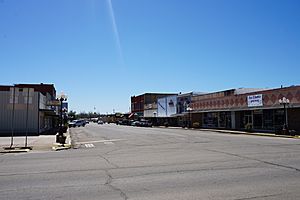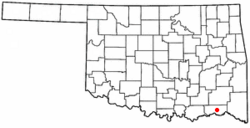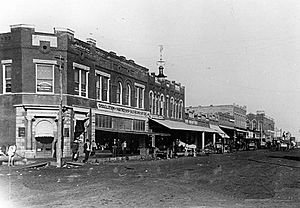Hugo, Oklahoma facts for kids
Quick facts for kids
Hugo, Oklahoma
|
|
|---|---|

Broadway Street in Hugo
|
|
| Nickname(s):
Circus City, USA
|
|

Location of Hugo, Oklahoma
|
|
| Country | United States |
| State | Oklahoma |
| County | Choctaw |
| Area | |
| • Total | 6.33 sq mi (16.39 km2) |
| • Land | 6.31 sq mi (16.34 km2) |
| • Water | 0.02 sq mi (0.05 km2) |
| Elevation | 551 ft (168 m) |
| Population
(2020)
|
|
| • Total | 5,166 |
| • Density | 818.83/sq mi (316.13/km2) |
| Time zone | UTC−6 (Central (CST)) |
| • Summer (DST) | UTC−5 (CDT) |
| ZIP Code |
74743
|
| Area code(s) | 580 |
| FIPS code | 40-36300 |
| GNIS feature ID | 2410805 |
Hugo is a city in southeastern Oklahoma, USA. It's the main city of Choctaw County. It is about 9 miles north of the Texas border. In 2020, about 5,166 people lived there.
The city was started in 1901. It was named after a famous French writer, Victor Hugo. After World War II, many circus companies and performers spent their winters in Hugo. There's even a special part of the cemetery for circus people. Close by is Goodland Academy, one of the oldest boarding schools west of the Mississippi River. It began in 1848 as a school for Native American children.
Hugo is in a part of Oklahoma called Little Dixie. This area was settled by Native American tribes, African Americans, and European Americans from the southeastern USA. It's also part of the "Choctaw Country" tourist area.
Contents
History of Hugo, Oklahoma
This area was once part of the Indian Territory. The US government moved Native American tribes here in the 1830s. This was part of a plan called Indian Removal. The Choctaw people, who the county is named after, were among those moved here. They were one of the "Five Civilized Tribes" because some had adopted parts of European-American culture. When they moved, they brought many enslaved African-Americans with them.
During the American Civil War, most Choctaw people sided with the Confederate South. After the war, the US government made a new treaty with them. One condition was that the Choctaws had to free their enslaved people. They also had to give these freedmen full citizenship rights in the Choctaw nation. This was similar to how the US was giving citizenship to former slaves in the South.
In 1902, the St. Louis, San Francisco and New Orleans Railroad built a new rail line. This line connected Hope, Arkansas, to Ardmore, Oklahoma. It crossed an older rail line that went from Monett, Missouri, to Paris, Texas. A town grew up where these lines crossed. This town was soon named Hugo. The wife of a local surveyor, W.H. Darrough, suggested the name. She was a big fan of the French writer Victor Hugo. When it was founded, Hugo was in Kiamitia County, part of the Pushmataha District of the Choctaw Nation.
As Indian Territory was nearing its end, people living there wanted it to become a state. They suggested a state called State of Sequoyah. This plan divided the lands of the five tribes into counties. Hugo was chosen as the main city for Hitchcock County in this plan. Even though Congress and the president didn't want Sequoyah to become a state, some of its proposed county borders were later used for counties in Oklahoma.
In southeastern Oklahoma, the borders for the future Choctaw County were mostly the same as Hitchcock County, Sequoyah. The proposed borders for Pushmataha County, Sequoyah also became the borders for Pushmataha County, Oklahoma. And McCurtain County, Oklahoma generally followed the borders proposed for McCurtain County, Sequoyah. These counties are next to Choctaw County.
Oklahoma Statehood and Changes
When Oklahoma became a state, counties were reorganized. Hugo was chosen as the county seat for the new Choctaw County. This was because it was already a major town in the area.
Under the Dawes Act, tribal lands were divided and given to individual tribal members. After this, the Choctaw Nation lost control of much of its land. Many European Americans bought this land.
Hugo: Circus City, USA
Since 1941, Hugo has been a home for circuses. The Al G. Kelly and Miller Brothers Circus moved here from Kansas that year. Vernon and Jewell Pratt, who owned a local grocery store, helped them move. In return, the circus gave free Sunday shows for many years.
Hugo became a popular place for circus and rodeo companies to spend the winter. This was because of its mild weather. Townspeople and circus performers became friends and worked together on community projects. At one time, about twenty circuses were based in Hugo. In 2018, three still operated there: Carson and Barnes, Kelly Miller, and Culpepper & Merriweather. These are all tent circuses that travel by road.
David Rawls (born 1948) grew up in a circus family. They performed with Famous Cole Circus. He learned all parts of the circus business. In 1984, he became the owner of his own show, Kelly Miller Circus. He sold it in 2009. During this time, he also served as Hugo's City Manager and later as Mayor.
A part of Mt. Olivet Cemetery is called Showmen's Rest. Circus owner D. R. Miller and rodeo cowboys Freckles Brown, Lane Frost, and Todd Whatley are buried there.
Hugo in the Late 20th Century
In late 1993, some serious events happened in Hugo. Before Christmas, there was a shootout in a Wal-Mart parking lot. In one week in December, two fires broke out. The first was at the Booker T. Washington gymnasium on December 26. On December 28, a fire started in Hugo's main business area. It destroyed five buildings and burned for four hours. The Belmont Hotel, which was being fixed up by a historical group, was also destroyed. Authorities thought these fires might have been set on purpose.
Points of Interest in Hugo
In 1937, artist Joseph Fleck painted a mural for the Hugo post office. It was called The Red Man of Oklahoma Sees the First Stage Coach. This was part of the Works Progress Administration program for public art. The building is now used by the Oklahoma School System. Murals like this were created across the US from 1934 to 1943.
Geography of Hugo
Hugo is in the middle of Choctaw County. The city covers about 6.33 square miles (16.39 square kilometers). Most of this is land, with a small amount of water. Hugo Lake is northeast of town. It is on the Kiamichi River. Roebuck Lake is south of town. It's an old channel of the Red River.
Hugo is the southern end of the Indian Nation Turnpike. This is a 105-mile highway that goes northwest to Interstate 40 in Henryetta. It helps people travel from southeastern Oklahoma to bigger cities like Oklahoma City and Tulsa.
Hugo's Climate
| Climate data for Hugo, Oklahoma | |||||||||||||
|---|---|---|---|---|---|---|---|---|---|---|---|---|---|
| Month | Jan | Feb | Mar | Apr | May | Jun | Jul | Aug | Sep | Oct | Nov | Dec | Year |
| Record high °F (°C) | 81 (27) |
86 (30) |
92 (33) |
94 (34) |
98 (37) |
105 (41) |
110 (43) |
110 (43) |
108 (42) |
100 (38) |
88 (31) |
84 (29) |
110 (43) |
| Mean daily maximum °F (°C) | 53.1 (11.7) |
58.3 (14.6) |
67.6 (19.8) |
76 (24) |
82.2 (27.9) |
89.2 (31.8) |
94.1 (34.5) |
94.5 (34.7) |
87.4 (30.8) |
77.7 (25.4) |
65.8 (18.8) |
55.8 (13.2) |
75.1 (23.9) |
| Mean daily minimum °F (°C) | 30.6 (−0.8) |
34.9 (1.6) |
43.3 (6.3) |
52.2 (11.2) |
59.7 (15.4) |
67.1 (19.5) |
70.3 (21.3) |
69.2 (20.7) |
63 (17) |
51.8 (11.0) |
42.7 (5.9) |
33.7 (0.9) |
51.5 (10.8) |
| Record low °F (°C) | 0 (−18) |
−6 (−21) |
7 (−14) |
26 (−3) |
36 (2) |
50 (10) |
54 (12) |
53 (12) |
38 (3) |
22 (−6) |
13 (−11) |
−4 (−20) |
−6 (−21) |
| Average precipitation inches (mm) | 2.2 (56) |
3.3 (84) |
4.2 (110) |
4.2 (110) |
6.0 (150) |
4.8 (120) |
2.8 (71) |
2.7 (69) |
4.5 (110) |
4.2 (110) |
4.0 (100) |
3.3 (84) |
46.1 (1,170) |
| Average snowfall inches (cm) | 1.3 (3.3) |
1.2 (3.0) |
0.4 (1.0) |
0 (0) |
0 (0) |
0 (0) |
0 (0) |
0 (0) |
0 (0) |
0 (0) |
0.1 (0.25) |
0.7 (1.8) |
3.4 (8.6) |
| Average rainy days | 6 | 6 | 8 | 8 | 8 | 7 | 5 | 5 | 6 | 6 | 6 | 7 | 83 |
| Source 1: weather.com | |||||||||||||
| Source 2: Weatherbase.com noaa.gov | |||||||||||||
People Living in Hugo
| Historical population | |||
|---|---|---|---|
| Census | Pop. | %± | |
| 1910 | 4,582 | — | |
| 1920 | 6,368 | 39.0% | |
| 1930 | 5,272 | −17.2% | |
| 1940 | 5,909 | 12.1% | |
| 1950 | 5,984 | 1.3% | |
| 1960 | 6,287 | 5.1% | |
| 1970 | 6,585 | 4.7% | |
| 1980 | 7,172 | 8.9% | |
| 1990 | 5,978 | −16.6% | |
| 2000 | 5,536 | −7.4% | |
| 2010 | 5,310 | −4.1% | |
| 2020 | 5,166 | −2.7% | |
| U.S. Decennial Census | |||
In 2000, there were 5,536 people living in Hugo. There were 2,309 households. About 29.4% of households had children under 18. About 37.4% were married couples.
The population was spread out by age. About 26.6% were under 18. About 20.3% were 65 or older. The average age was 38 years. For every 100 females, there were about 80 males.
The average income for a household in Hugo was $19,321. For families, it was $26,523. About 29.4% of the people lived below the poverty line. This included 43.5% of those under 18.
Hugo's Economy
For a long time, Hugo's economy depended on farming (especially cotton), timber, and ranching. As farming became more modern, machines replaced many farm jobs.
Since the 1940s, circuses have used Hugo as their winter home. Some regional circuses are based here. The circus owners and performers often get involved in city life.
Changes in the economy led to new developments. In the 1970s, the Kiamichi Technology Center opened. The "Agriplex," which was originally the Choctaw County Agricultural Center, also opened.
Transportation in Hugo
Hugo is where the Indian Nation Turnpike begins in the south. U.S. Highway 70 runs through the city from west to east. It connects Hugo to Durant, which is 53 miles west. It also connects to Idabel, which is 43 miles east. U.S. Highway 271 goes south from Hugo. It leads 26 miles to Paris, Texas.
Hugo has a city-run airport called Stan Stamper Municipal Airport. It has one runway that is 4,007 feet long. Ten aircraft are based at the airport. It helps with medical air ambulance flights. It also handles cargo flights for southeastern Oklahoma. These flights are operated by Martinaire for UPS.
Historic Places in Hugo
Several places in Hugo are listed on the National Register of Historic Places. This means they are important to history.
- Frisco Depot Museum and Harvey House Restaurant (NR 80003259). This train station was built in 1914. It was used until the 1960s. Now, it's a museum with many interesting things. These include a model railway, a tiny circus, and old telephone equipment. It also has items about railroads and local history. A former lunchroom, called a Harvey House, has been restored. The rooms where the "Harvey Girls" lived are also preserved upstairs. An RV Park is next to the depot.
- Hugo Historic District (NR 80003260). This area covers 12 blocks. It has about 64 buildings, mostly built between 1900 and 1920. It includes the train station, three hotels, and many shops. It shows what a railroad town looked like in the early 1900s.
- Hugo National Guard Armory (NR 88001378)
- Hugo Public Library (NR 88001379)
- Speer School (NR 88001380)
- Rose Hill Plantation (NR 10000069)
- Everidge Cabin and Cemetery (NR 82003674)
Famous People from Hugo
- Henry G. Bennett: He was the longest-serving president of Oklahoma State University.
- Buckskin Bill Black (1929–2018): He was a children's TV host in Louisiana. He grew up in Hugo.
- Lane Clyde Frost (1963–1989): He was a world champion bull rider.
- William Judson Holloway: He was a former governor of Oklahoma.
- William Judson Holloway, Jr.: He was a judge for the United States Court of Appeals for the Tenth Circuit.
- James Ling: He was a businessman who started Ling-Temco-Vought.
- Bill Moyers: He is a journalist and was a White House Press Secretary.
- Patrick W. O'Reilly: He was a lawyer and politician.
- Clancy Smith: She was born and raised in Hugo. She became a judge on the Oklahoma Court of Criminal Appeals.
- B. J. Thomas (1942–2021): He was a singer known for hits like "Raindrops Keep Fallin' on My Head".
- Wallace Willis: He was an African-American musician and songwriter. He was born into slavery. He lived near Hugo when he wrote "Swing Low, Sweet Chariot" in 1840. He had been brought to Indian Territory by his owner, a wealthy Choctaw farmer.
See also
 In Spanish: Hugo (Oklahoma) para niños
In Spanish: Hugo (Oklahoma) para niños




